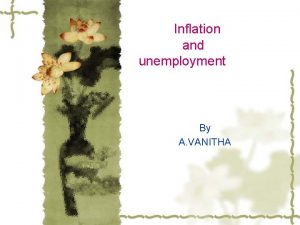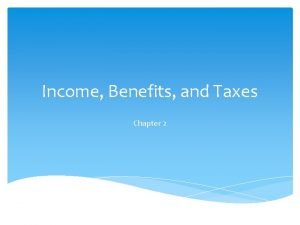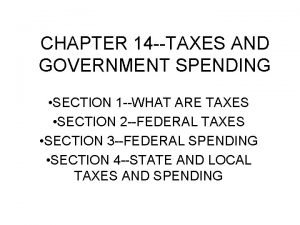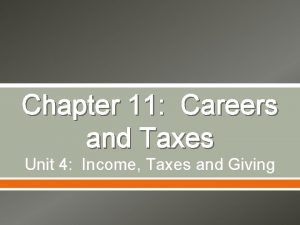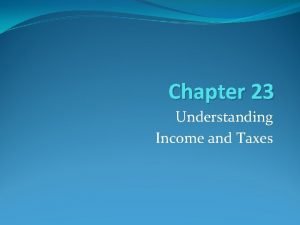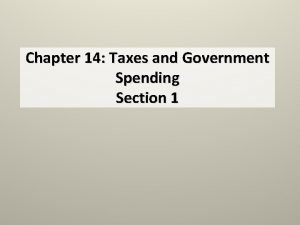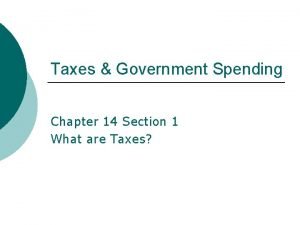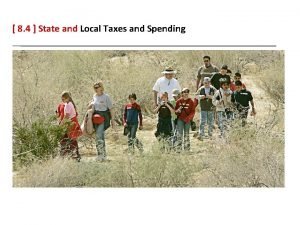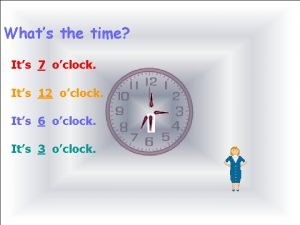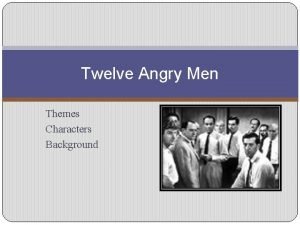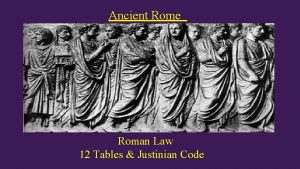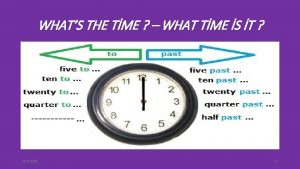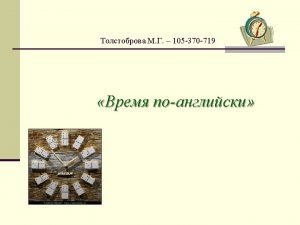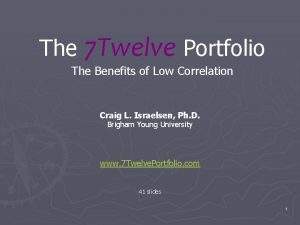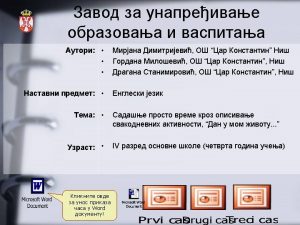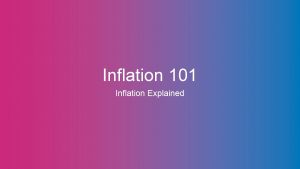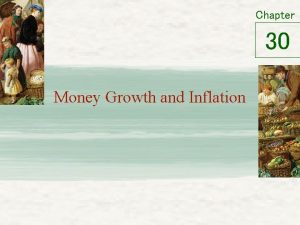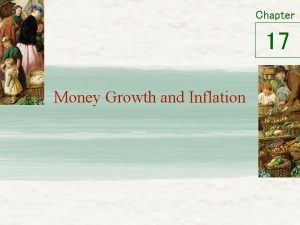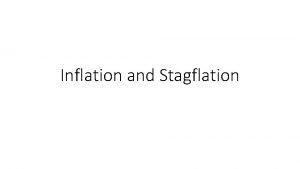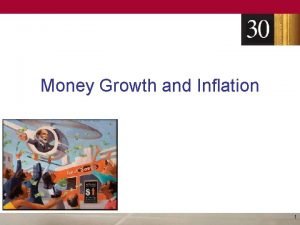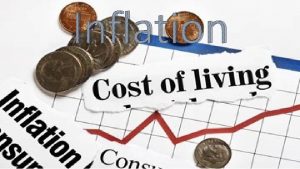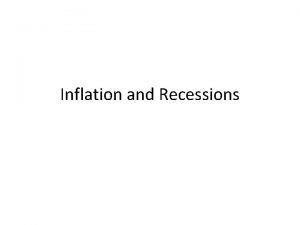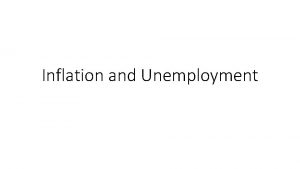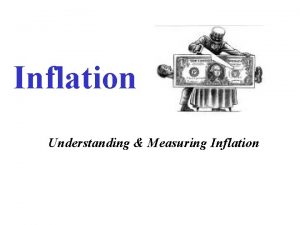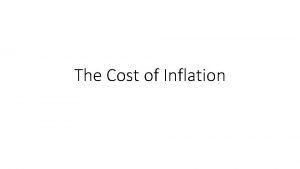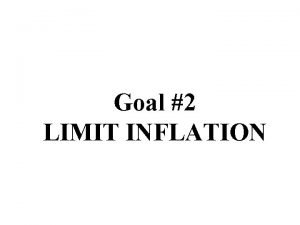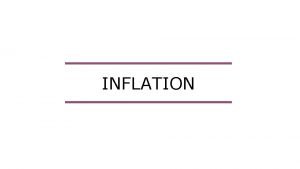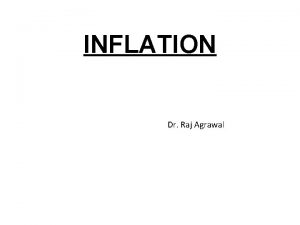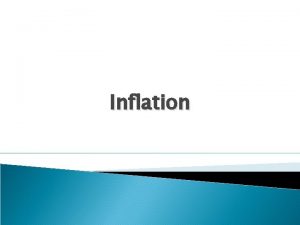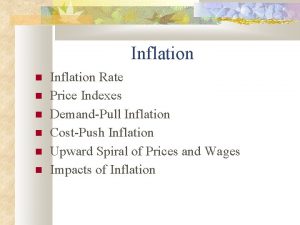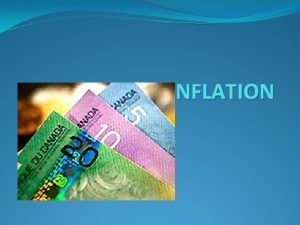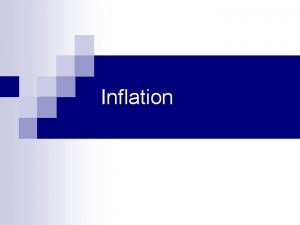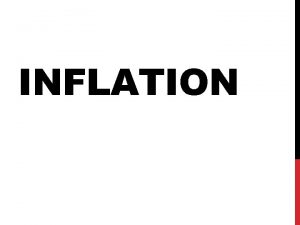CHAPTER TWELVE TAXES AND INFLATION TAXES IN THE






































- Slides: 38

CHAPTER TWELVE TAXES AND INFLATION

TAXES IN THE U. S. n CORPORATE TAXES • forms of business are taxed differently 3 single proprietor and partnership income is taxed at personal income rates 3 corporate income may be taxed twice – – once as it is earned using the corporate income rates again as dividend income using the personal rates

CORPORATE TAX RATES n MARGINAL TAX RATES • are the most important for the corporation and represent the tax on additional income earned

CORPORATE TAX RATES n MARGINAL TAX RATES • are the rates on the next dollar earned

CORPORATE TAX RATES n MARGINAL TAX RATES: An Example Suppose a corporation earns $85, 000 It pays. 15 on first $50, 000 = $7, 500. 25 on next $25, 000 = $6, 250. 34 on next $10, 000 = $3, 400 Total tax on$85, 000 = $17, 150

CORPORATE TAX RATES n CALCULATING AVERAGE TAX RATE • the average tax rate = TOTAL TAX PAID TOTAL TAXABLE INCOME

CORPORATE TAX RATES n CALCULATING AVERAGE TAX RATE • the average tax rate is equal to the An Example $17, 150 / $85, 000 = 20. 18%

PERSONAL INCOME TAXES n CALCULATING AFTER-TAX INCOME GROSS INCOME - ADJUSTMENTS ADJUSTED GROSS INCOME - DEDUCTIONS TAXABLE INCOME - TAXES AFTER-TAX INCOME

PERSONAL INCOME TAXES n EXAMPLE: A MARRIED COUPLE ARE EVALUATING AN INVESTMENT Assume: No Bracket “Creep” Taxable Income = $80, 000 Marginal Tax rate =. 28 Possible Investment Income: Tax (. 28 x $3, 000) = $840

PERSONAL INCOME TAXES n EXAMPLE: A MARRIED COUPLE ARE EVALUATING AN INVESTMENT Assume: Bracket “Creep” Possible Investment Income: $20, 000 Tax. 28 x 16, 900 = $4, 732. 31 x 3, 100 = $ 961 20, 000 = $5, 693

PERSONAL INCOME TAXES n TAX-EXEMPT BONDS • DEFINITION: securities whose income is not subject to federal income taxes

PERSONAL INCOME TAXES n TAX-EXEMPT BONDS • most income from bonds issued by states, municipalities, and their agencies need not be included in taxable income for federal returns

PERSONAL INCOME TAXES n TAX-EXEMPT BONDS • to calculate fully-taxable-equivalent yield of a tax-exempt bond use the formula yield = __i__ 1 - t where t = the investor’s marginal tax rate i = the tax-exempt yield

TAX TREATMENT FOR CAPITAL GAINS AND LOSSES n CATEGORIES OF GAIN • depend on holding periods and tax treatment HOLDING PERIOD TAX TREATMENT

TAX TREATMENT FOR CAPITAL GAINS AND LOSSES n CATEGORIES OF GAIN • depend on holding periods and tax treatment HOLDING PERIOD • Less than one year TAX TREATMENT ordinary income

TAX TREATMENT FOR CAPITAL GAINS AND LOSSES n CATEGORIES OF GAIN • depend on holding periods and tax treatment HOLDING PERIOD • Less than one year • 12 to 18 months TAX TREATMENT ordinary income max rate = 28%

TAX TREATMENT FOR CAPITAL GAINS AND LOSSES n CATEGORIES OF GAIN • depend on holding periods and tax treatment HOLDING PERIOD • Less than one year • 12 to 18 months • more than 18 months TAX TREATMENT ordinary income max rate = 28% 20%*

TAX TREATMENT FOR CAPITAL GAINS AND LOSSES n CATEGORIES OF GAIN • depend on holding periods and tax treatment HOLDING PERIOD • Less than one year • 12 to 18 months • more than 18 months TAX TREATMENT ordinary income max rate = 28% 20%* * unless taxpayer is in the 15% tax bracket in which case the rate = 10%

TAX TREATMENT FOR CAPITAL GAINS AND LOSSES n CATEGORIES OF GAIN • depend on holding periods and tax treatment HOLDING PERIOD • Less than one year • 12 to 18 months • more than 18 months • five years or more TAX TREATMENT ordinary income max rate = 28% 20%* 18%**

TAX TREATMENT FOR CAPITAL GAINS AND LOSSES n CATEGORIES OF GAIN • depend on holding periods and tax treatment HOLDING PERIOD • five years or more TAX TREATMENT 18%** **Exception: If taxpayer is in 15% tax bracket, the asset must have been sold in the year 2001 or later, then rate = 8%

TAX TREATMENT FOR CAPITAL GAINS AND LOSSES n CATEGORIES OF GAIN • depend on holding periods and tax treatment HOLDING PERIOD • Less than one year • 12 to 18 months • more than 18 months • five years or more TAX TREATMENT ordinary income max rate = 28% 20%* 18%**

INFLATION IN THE U. S. n INFLATION • DEFINITION: the percentage change in a specific cost-of-living index at various points in time.

INFLATION IN THE U. S. n INFLATION • cost-of-living index 3 the “overall” price level computed for a “basket of goods”

INFLATION IN THE U. S. n PRICE INDICES • measure changes in prices relative to a fixed period in time usually called the base period

INFLATION IN THE U. S. n PRICE INDICES • the Consumer Price Index (CPI) is calculated by the U. S. Bureau of Labor Statistics in the Department of Labor

INFLATION IN THE U. S. n PRICE INDICES • the Consumer Price Index (CPI) is calculated by the U. S. Bureau of Labor Statistics in the Department of Labor • the Bureau uses a “market basket” of over 2000 U. S. consumer goods and services

INFLATION IN THE U. S. n NOMINAL AND REAL RETURNS • Fisher Model of Real Returns stated that real returns are important to investors • they represented how much purchasing power has changed

INFLATION IN THE U. S. n NOMINAL AND REAL RETURNS • price change may impact an asset’s nominal return

INFLATION IN THE U. S. n NOMINAL AND REAL RETURNS • adjustments to the nominal return are needed to remove the effects on purchasing power of inflation or deflation

INFLATION IN THE U. S. n NOMINAL AND REAL RETURNS • FORMULA FOR CALCULATING REAL RETURNS where C 0 = CPI at the beginning of period C 1 = CPI at the end of the period NR = the time period’s nominal return RR =the real return for the period

INFLATION IN THE U. S. n NOMINAL AND REAL RETURNS • a quick calculation of the real return NR - IR = RR where IR = the rate of inflation for the period NR= the nominal return RR= the real return

INFLATION IN THE U. S. n THE EFFECT OF INVESTOR EXPECTATIONS • investors’ attitudes toward inflation show they are concerned with real returns

INFLATION IN THE U. S. • THE EFFECT OF INVESTOREXPECTATIONS Looking to the future E(RR) = E(NR) - E(CCL) where E(RR) = the expected real return E(NR) = the expected nominal return E(CCL)= the expected inflation rate

STOCK RETURNS AND INFLATION n OVER LONG PERIODS OF TIME • common stocks generated large, positive real returns

STOCK RETURNS AND INFLATION n OVER LONG PERIODS OF TIME • T-bills produced much lower, positive real returns

STOCK RETURNS AND INFLATION n OVER SHORT PERIODS OF TIME • stock returns are not positively related to either actual or expected rates of inflation

STOCK RETURNS AND INFLATION n OVER SHORT PERIODS OF TIME • stock returns are positively related to both actual and expected rates of inflation

END OF CHAPTER 12
 Betty baker tongue twister
Betty baker tongue twister Types of unemployment
Types of unemployment Chapter 2 income benefits and taxes
Chapter 2 income benefits and taxes Chapter 14: taxes and government spending section 1
Chapter 14: taxes and government spending section 1 Foundations u.com
Foundations u.com Chapter 23 understanding income and taxes
Chapter 23 understanding income and taxes Chapter 14 taxes and government spending
Chapter 14 taxes and government spending Chapter 2 financial statements taxes and cash flow
Chapter 2 financial statements taxes and cash flow Chapter 14 taxes and government spending
Chapter 14 taxes and government spending Why printing money causes inflation
Why printing money causes inflation Loss contingency journal entry
Loss contingency journal entry Tax loss carry forward
Tax loss carry forward State and local taxes and spending
State and local taxes and spending Lesson twelve saving and investing
Lesson twelve saving and investing Which solid figure has 6 faces 8 vertices and 12 edges
Which solid figure has 6 faces 8 vertices and 12 edges Payroll accounting journal entries
Payroll accounting journal entries It's 7 o'clock
It's 7 o'clock What are the terrible twelve water pollution
What are the terrible twelve water pollution Tcms brighton
Tcms brighton 12 angry men background
12 angry men background 450 bc rome
450 bc rome Si in ius vocat ito
Si in ius vocat ito Twelve principles of green chemistry
Twelve principles of green chemistry Eleven twelve thirteen fourteen fifteen
Eleven twelve thirteen fourteen fifteen Roman twelve tables laws
Roman twelve tables laws Roman law code
Roman law code 12 powerful words
12 powerful words It's twenty to nine
It's twenty to nine Whats a quarter past 9
Whats a quarter past 9 12 step facilitation handbook
12 step facilitation handbook It takes ten identical pieces to form a circular track
It takes ten identical pieces to form a circular track 7 12 portfolio
7 12 portfolio Josie is twelve last year
Josie is twelve last year High twelve international
High twelve international Twenty past six
Twenty past six There are twelve months in a year.
There are twelve months in a year. What was the main idea of the twelve tables?
What was the main idea of the twelve tables? It's ten past two
It's ten past two Book of the twelve
Book of the twelve

